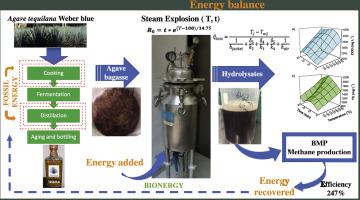Biomass & Bioenergy ( IF 5.8 ) Pub Date : 2020-09-28 , DOI: 10.1016/j.biombioe.2020.105753 Abigail Hernández-Vázquez , Sergio Hernández , Irmene Ortíz

|
In this study, agave bagasse (a lignocellulosic residue) was pretreated by steam explosion to increase the solubility of carbohydrates in the hydrolysates. The operational variables studied were pressure (0.28, 0.47, and 0.67 MPa, corresponding to 116, 142, and 154 °C, respectively) and pretreatment time (5, 10, 15, and 20 min). The conditions that favored the highest solubilization of glucose (66 ± 4 mg L−1), arabinose (160.31 ± 3.2 mg L−1), and the chemical oxygen demand (COD, 4395.71 ± 22.44 mg L−1) were 154 °C and 10-min. On the other hand, the maximum solubilization of total carbohydrates (TC, 2177.99 ± 197.22 mg L−1) and xylose (43 ± 2.8 mg L−1) was obtained at 154 °C and 15-min. Pretreatments catalyzed with H2SO4 at 154 °C and 10-min resulted in 3, 2.7, and 100-times TC, glucose and xylose concentrations, respectively, as compared to the uncatalyzed pretreatment. However, concentrations of potential inhibitor compounds (i.e., acetic acid, furfural, and hydroxymethylfurfural) increased as well, 26, 120 and 18-times, respectively. A biochemical methane potential (BMP) test of the hydrolysates resulting from the 154 °C-10 min conditions was used to calculate the energy balance of their conversion to methane. When considering only the energy invested in the pretreatment, the process showed an efficiency of 247%, thus being energetically feasible. The integration of methane production to the tequila processes could be implemented using the steam flow already present in the process, improving energy efficiency and reducing the environmental impact of this industry.
中文翻译:

龙舌兰蔗渣水热预处理生产生物甲烷:操作条件和能量平衡
在这项研究中,龙舌兰蔗渣(木质纤维素残留物)通过蒸汽爆炸进行预处理,以提高碳水化合物在水解产物中的溶解度。研究的操作变量是压力(0.28、0.47和0.67 MPa,分别对应于116、142和154°C)和预处理时间(5、10、15和20分钟)。葡萄糖(66±4 mg L -1),阿拉伯糖(160.31±3.2 mg L -1)和化学需氧量(COD,4395.71±22.44 mg L -1)最高溶解度的条件是154°C 10分钟 另一方面,总碳水化合物(TC,2177.99±197.22 mg L -1)和木糖(43±2.8 mg L -1)的最大溶解度)是在154°C和15分钟下获得的。H 2 SO 4催化的预处理与未催化预处理相比,在154°C和10分钟时,TC,葡萄糖和木糖浓度分别为3倍,2.7倍和100倍。但是,潜在抑制剂化合物(例如乙酸,糠醛和羟甲基糠醛)的浓度也分别增加了26倍,120倍和18倍。在154°C-10分钟的条件下产生的水解产物的生化甲烷潜力(BMP)测试用于计算其转化为甲烷的能量平衡。当仅考虑在预处理上投资的能量时,该方法的效率为247%,因此在能源上是可行的。可以使用过程中已经存在的蒸汽流将甲烷生产整合到龙舌兰酒过程中,











































 京公网安备 11010802027423号
京公网安备 11010802027423号